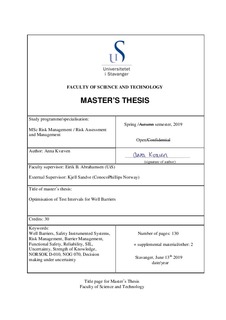| dc.contributor.advisor | Abrahamsen, Eirik | |
| dc.contributor.advisor | Sandve, Kjell | |
| dc.contributor.author | Kvæven, Anna | |
| dc.coverage.spatial | Norway | nb_NO |
| dc.date.accessioned | 2019-11-03T09:18:04Z | |
| dc.date.available | 2019-11-03T09:18:04Z | |
| dc.date.issued | 2019-06-13 | |
| dc.identifier.uri | http://hdl.handle.net/11250/2626225 | |
| dc.description | Master's thesis in Risk management | nb_NO |
| dc.description.abstract | The common approach among operators on the Norwegian Continental Shelf to verify the functional integrity of well barriers, including the safety instrumented systems in wells, is to schedule proof tests according to the time – based requirements for well barrier components in the NORSOK D – 010 standard for well integrity. Due to observed indications of high component reliabilities by operators, it is believed that changing the maintenance strategy for well barrier components to a reliability performance – based approach where proof tests are scheduled according to demonstrated safety integrity level (SIL) in operation can yield substantial annual cost savings. However, todays recommended procedures for SIL verification and associated updating of component test intervals for well barrier components are associated with uncertainty.
In this thesis, a new and integrated approach for SIL verification and optimisation of component test intervals with added weight to uncertainties is suggested to identify optimum test intervals for well barrier components. To demonstrate the use of the suggested approach, a reliability/availability case analysis of the safety instrumented function “Isolation of production bore in one topside well from the production manifold/flowline (ESD)” in offshore production wells is performed based on historical component data provided by ConocoPhillips Norway. A checklist and decision framework to identify and communicate the uncertainties of the reliability analysis is developed to provide broad decision support in optimisation of test intervals.
The case analysis identified that the reliability of the PMV and PWV is significantly better than the DHSV. The uncertainty in the analysis results is identified as medium. The main sources of uncertainty are identified as differing operating environments between wells, and the applicability of the exponential lifetime distribution to model component lifetimes. Taking the uncertainties of the analysis into account, optimum component test intervals were identified as 6 months for the PMV/PWV, and 3 months for the DHSV, with a possibility for further extension if wells included in the data are filtered on operating environment. The documented historical reliability performance of well barrier components in this thesis shows that it can be justified to extend component test intervals beyond the requirements in NORSOK D-010, in order to keep the risk of the activities as low as reasonably practicable. | nb_NO |
| dc.language.iso | eng | nb_NO |
| dc.publisher | University of Stavanger, Norway | nb_NO |
| dc.relation.ispartofseries | Masteroppgave/UIS-TN-ISØP/2019; | |
| dc.subject | SIL | nb_NO |
| dc.subject | NORSOK D010 | nb_NO |
| dc.subject | NOG 070 | nb_NO |
| dc.subject | well barriers | nb_NO |
| dc.subject | safety instrumented systems | nb_NO |
| dc.subject | risk management | nb_NO |
| dc.subject | barrier management | nb_NO |
| dc.subject | functional safety | nb_NO |
| dc.subject | reliability | nb_NO |
| dc.subject | uncertainty | nb_NO |
| dc.subject | strength of knowledge | nb_NO |
| dc.subject | desicion making under uncertainty | nb_NO |
| dc.subject | risikostyring | nb_NO |
| dc.title | Optimisation of Test Intervals for Well Barriers | nb_NO |
| dc.type | Master thesis | nb_NO |
| dc.subject.nsi | VDP::Social science: 200 | nb_NO |
| dc.subject.nsi | VDP::Technology: 500 | nb_NO |
| dc.source.pagenumber | 130 | nb_NO |
